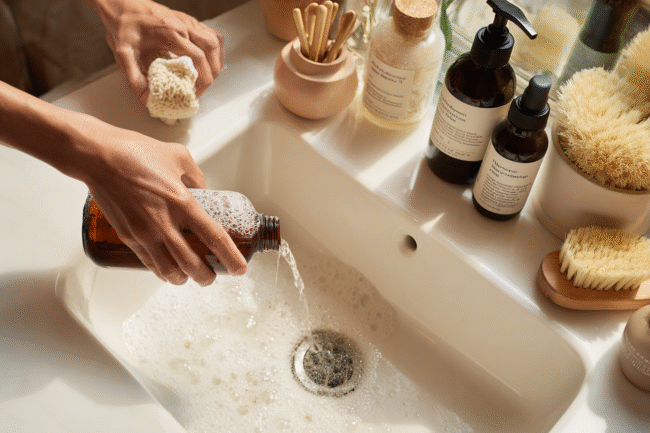You notice the bathroom sink draining a little slower than usual. Not completely clogged, just sluggish. You make a mental note to deal with it later. A few weeks pass, and that slow drain becomes a daily annoyance. Before long, you’re standing in ankle-deep water during your morning shower.
Sound familiar? Most homeowners treat drain problems as sudden emergencies, but the truth is they develop gradually over weeks and months. Hair combines with soap residue, toothpaste, and other bathroom products to create buildup that gets worse over time. The good news is that a few simple drain maintenance habits prevent most clogs from ever forming.
This guide shows you practical routines that keep your bathroom drains flowing smoothly. You’ll learn what you can handle yourself and when bringing in professionals makes sense for your home.
Why Drain Maintenance Actually Matters
Think about how you maintain your car. You change the oil regularly because waiting for engine failure costs thousands more than preventive care. Your drains work the same way.
A quick glance at the numbers tells the story. Emergency drain cleaning during a backup typically runs $200-400, often on a weekend when rates are higher. Annual preventive maintenance costs $100-150 and catches problems before they become emergencies. The math is simple, but the benefits go beyond dollars.
Clogged drains create stress. Your morning routine gets disrupted. Water sits in sinks and tubs, creating odors and potential water damage. In severe cases, backups can overflow onto bathroom floors, damaging cabinets, flooring, and drywall. Regular drain maintenance eliminates these headaches entirely.
Your home’s value depends partly on working plumbing. When buyers test faucets during home inspections, slow drains raise red flags about deferred maintenance. Clean, fast-draining fixtures signal a well-maintained home.
Daily Habits That Prevent Most Problems
The best drain maintenance takes less than a minute each day. These small habits stop buildup before it starts.
Brush your hair before showering. Loose hair that comes out during shampooing is what clogs drains. A quick brush removes most of it before you step into the tub. This simple step eliminates 70-80% of potential hair clogs.
Use drain catchers religiously. Those mesh screens cost a few dollars and catch hair before it enters your pipes. Empty them after every shower. It takes 15 seconds and prevents months of slow drainage later.
Run hot water after each use. Let hot tap water flow for 15-20 seconds after brushing teeth, washing your face, or any sink use. Hot water melts soap residue and pushes small particles through your pipes before they accumulate.
Keep bathroom products away from drains. Cotton swabs, dental floss, hair ties, and razor blade covers seem small, but they create snags where hair and soap can catch. Toss them in the trash, not the sink.
Wipe out sinks regularly. A quick wipe with a dry cloth removes the soapy film that coats your basin. Less soap film going down the drain means less buildup in your pipes.
These habits require almost no effort, yet they prevent the majority of bathroom drain clogs. Make them automatic, and you’ll rarely think about drain problems.

Your Monthly Maintenance Routine
Once a month, spend 10 minutes giving your drains some attention. This simple routine keeps them flowing freely.
Hot water flush. Once monthly, bring a full kettle of water to a rolling boil. Remove any standing water from your sink or tub, then pour the boiling water directly down the drain in a steady stream. The heat melts accumulated soap scum and grease. Wait five minutes, then run cold water for 30 seconds. This temperature shock helps dislodge any remaining debris.
One caution: boiling water works for metal pipes but can damage older PVC pipes. If your home has plastic drain pipes, use very hot tap water instead.
Enzyme drain treatments. These biological cleaners contain helpful bacteria that digest organic matter like hair, soap, and toothpaste. Unlike harsh chemical cleaners, enzymes won’t damage your pipes or harm septic systems. Pour the recommended amount down each drain before bed, let it work overnight, then flush with warm water in the morning. Use these monthly for prevention, not to clear existing clogs.
Clean drain stoppers and covers. Remove sink stoppers and shower drain covers. You’ll likely find hair wrapped around them and gunk built up underneath. Clean everything thoroughly with an old toothbrush and hot soapy water. Rinse well before reinstalling. This prevents surface buildup from washing deeper into your pipes.
Check for early warning signs. While cleaning, look for slow drainage, gurgling sounds, or unusual odors. These signal developing problems. Catching them at this stage means simple fixes instead of major clogs.
Keep supplies ready. Store a mesh drain catcher, enzyme cleaner, and rubber gloves under each bathroom sink. Having tools on hand makes maintenance happen instead of getting postponed.
This monthly routine takes less time than dealing with one clogged drain emergency. Make it a habit on the first weekend of each month, right along with changing HVAC filters and testing smoke detectors.
Seasonal Deep Maintenance
Every three months, go a bit deeper with your drain care. Seasonal maintenance addresses buildup that monthly routines miss.
The baking soda and vinegar treatment is popular online, but let’s be realistic about what it does. Pour half a cup of baking soda down the drain, follow with half a cup of white vinegar, cover the drain, and wait 15 minutes. The fizzing reaction loosens light surface buildup and freshens drains. Finish with hot water.
This method won’t clear serious clogs or dissolve hair. Think of it as a supplemental freshening technique, not a substitute for proper drain maintenance. It’s safe for all pipes and costs pennies, so it’s worth doing quarterly even with modest results.
Check for mineral deposits. If you have hard water, white or brownish crusty buildup can form around drain openings. This restricts water flow and catches debris. Scrub visible deposits with an old toothbrush dipped in white vinegar. For stubborn buildup, soak a cloth in vinegar, wrap it around affected areas, and leave it for an hour before scrubbing.
Inspect drain seals. Check the rubber seals around sink stoppers and bathtub drains. Cracked or worn seals let debris slip past into pipes. Replace damaged seals before they cause problems.
Adjust your routine seasonally. Summer often means more frequent showering and increased product use. Fall brings hair shedding as weather changes. Winter heating can dry out drain seals. Spring cleaning is perfect for thorough drain attention. Adapt your maintenance to seasonal patterns in your household.

When Professional Drain Maintenance Makes Sense
You can prevent most drain problems yourself, but professional maintenance offers benefits no homeowner can replicate. Understanding when to call in experts protects your plumbing investment and prevents unexpected problems.
Annual professional inspections catch hidden issues. Even with excellent home maintenance, deposits build up deep in your pipes where you can’t reach. Tree roots can infiltrate underground lines. Pipes develop tiny cracks or slight sagging that gradually worsens. Professional plumbers use camera inspection technology to see inside your pipes and identify developing problems before they cause backups or damage.
Professional equipment cleans more thoroughly. Hydro-jetting uses high-pressure water to scour pipe walls clean, removing years of accumulated buildup. This thorough cleaning restores pipes to near-original flow capacity. Motorized drain augers clear blockages deep in your system that home tools can’t reach. These professional methods extend the life of your plumbing and prevent recurring problems.
Older homes benefit most from professional care. If your home is more than 30 years old, your pipes have decades of buildup and potential wear. Cast iron pipes corrode over time. Clay sewer lines crack and separate. Galvanized steel pipes develop rust buildup. For older plumbing systems, professional drain cleaning services provide preventive care that spot problems early and maintain proper flow through aging pipes.
Multiple slow drains signal bigger issues. When several fixtures drain slowly at the same time, the problem lies in your main sewer line, not individual drains. This requires professional diagnosis and equipment. Attempting DIY fixes on main line problems often makes situations worse and costlier to repair.
Recurring problems need professional diagnosis. If you’re clearing the same drain every few months despite regular maintenance, something else is wrong. A partially collapsed pipe, improper venting, or invasive tree roots might be causing repeat clogs. Professionals can identify root causes and provide lasting solutions.
Think of it like HVAC maintenance. You change filters yourself, but you hire professionals for annual system inspections and tune-ups. The same logic applies to drains. Handle routine maintenance yourself, but schedule professional service annually to protect your investment.
Professional drain maintenance typically costs $100-150 annually and includes camera inspection, hydro-jetting or thorough snaking, and a detailed report on your plumbing condition. That’s less than one emergency service call, and it keeps your entire system healthy.
Your Drains Deserve Attention
Drain maintenance isn’t glamorous, but it’s one of the simplest ways to protect your home. A few minutes of attention each month prevents the stress, expense, and disruption of clogged drains and emergency repairs.
Start with the daily habits: brush hair before showering, use drain catchers, run hot water after every use. Add monthly enzyme treatments and quarterly deep cleaning. Schedule annual professional drain maintenance to catch problems early and keep your entire system healthy.
Small, consistent efforts make a huge difference. Your drains will flow freely, your mornings will run smoothly, and you’ll avoid the headaches that come with neglected plumbing. That’s time and money well spent on protecting your home.

